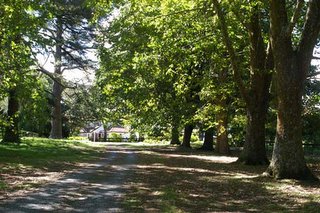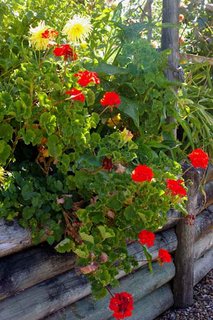Early Settlers' Gardens
1840's-1860's (based on a chapter by Katherine Raine, in A History of the Garden in New Zealand, ed. Matthew Bradbury, Viking, 1995.
Although life in New Zealand for the early European settlers meant backbreaking work just to clear enough land to survive, Katherine Raine maintains that "many immigrants considered ornamental trees and flowering plants to be essential in their new homes...in fact, the first garden in Auckland was apparently a small planting of bulbs" (65).
Of course, so many miles away from home, facing many hardships and new experiences, the English settlers were most anxious to recreate as familiar a landscape as possible. Thus, "fragrant flowers and familiar trees 'from home' were popular" (65), and represented to early settlers a determination to recreate "a 'civilized' way of life" (66). However, the creation of ornamental gardens quickly became the province of women, "the men being too busy for anything so purely ornamental as flowers" (Adela Stewart, My Simple Life in New Zealand, in Raine 66).
These women brought with them a great deal of horticultural baggage from England, in terms of horticulture, the practice of which was extremely popular at that time in the homeland, especially among the newly-risen middle class. As well, flower gardening had just become an acceptable pastime for women. This trend was mostly instigated by the writings of Mrs. Jane Loudon, wife of the famed horticulturist J.C. Loudon. Her Gardening for Ladies (1840) gave specific and practical information about how to garden without compromising one's ladylike demeanor. New Zealand settler women probably had to dig and labor with somewhat more energy than Mrs. Loudon recommended, but her book gave them license to garden with their husbands' approval. After all, as Louisa Johnson wrote in her 1845 book Every Lady Her Own Flower Garden , "nothing humanizes and adorns the female mind more than a taste for ornamental flower gardening" (in Raine 67).
J.C. Loudon's influence, too, must be recognized in the plants chosen to fill a new settler's garden. Loudon stated categorically, in 1838, that "everything in modern landscape gardening depends on the use of foreign trees and shrubs. No residence in the modern style can have a claim to be considered to be laid out in good taste, in which all the trees and shrubs are not foreign ones, or improved varieties of indigenous ones (in Raine, 66). I suppose that the new New Zealanders could have interpreted Loudon's dictum as license to use the natives of their new land in their gardens, but instead mostly they took it as encouragement to seek out the latest European introductions, as a signal of their wealth, taste, and modernity.
On the other hand, New Zealand did provide "a wealth of novel native plants" (67) back to European botanists and novelty-hungry gardeners. The craze for exotic plants in this era resulted in a huge exchange of plants from and to all parts of the globe. Garden styles evolved to show off these rarities as if in a jeweler's showcase, each planted at a good distance from its neighbors, in tidy rows. Loudon's description of this fashionable 'gardenesque' style is revealing: "that kind of scenery, which is best calculated to display the individual beauty of trees, shrubs, and plants in a state of nature; the smoothness and greenness of lawns; and the smooth surfaces, curved directions, dryness and firmness of gravel walks; in short, it is the style best calculated to display the art of the gardener." (in Raine 79). This style was considered much more civilized and tasteful than the 'cottage style' where all the plants were jumbled together.
The ideas of taste that these gardeners brought with them were slow to change in this somewhat isolated colony. Middle class New Zealanders sought to recreate the "rather prim ideas" (67) of gardening that represented what they had left behind, styles suited to the suburban sections around British cities, while the upper class settlers wanted "park-like grounds with smooth lawns and picturesquely disposed woods" (68). Both of these styles are still much in evidence throughout New Zealand today. Houses built during this era still proudly display now-mature European trees planted by the first settlers, such as these wonderful sycamores and oaks lining the drive at Chiddingfold Garden near Cambridge, NZ.

In terms of the overall settlements, as the men cleared the flax and tussock, they quickly planted their own imported plants to create the desired landscape, thus dramatically changing the ecology and look of New Zealand in a fashion that remains to this day. European pasture grasses, boundary hedges and windbreak plantings (including gorse and hawthorn, now much regretted), and fast growing trees such as willow and poplar were soon common, as was Australian eucalyptus, which also did well.The near-constant winds of this island nation necessitate extremely tall windbreak hedging, and these impressive hedges are a landmark of the New Zealand landscape to this day.

Horticultural societies sprang up "to foster enthusiasm for plants of all kinds and to encourage the exchange of information" (71) and Raine comments that "the reports of the societies' first shows reflect a certain spirit of chauvinistic pride" (71). As with vegetables, the settlers soon came to realize that the virgin soils of their new home could support flowers of astonishing vigor. In 1843, the Auckland Agricultural and Horticultural Society awarded prizes for "gladioli, and other Cape bulbs...heart's ease (pansies)...moss roses, hollyhock, ranunculus, marigolds, and clove carnations" (73) as well as for fruits and vegetables. The variety represented by this list is all the more amazing when we remember that every plant on it had to come through a lengthy and often treacherous sea voayge as a seed, slip, bulb, corm, tuber, or rooted plant. One of the favourite first imports, prized for how large it grows in this climate, was the pelargonium, still a common sight in front gardens throughout the country.

Despite their desire to plant their gardens mostly with specimens from Europe, however, there is some evidence that the early settlers admired some New Zealand natives from the beginning. Early botanical illustrations of these plants abound. Indeed, the directors of The London Historical Society and the New Zealand Company commissioned Martha King to create scientifically-correct illustrations of the native flora in 1842, making her New Zealand's first resident botanical artist. As well, some early settlers left a few native tree ferns and shrubs in their settlement yards and built their gardens around them. Nevertheless, "neatness was the cardinal virtue, as the owners of such gardens often did the work themselves and were proud of their skills in keeping the paths well-maintained and the plants pruned" (80).
In particula
 r, a spacious sweep of English turf was much prized and labored-over, representing (as it still does to many New Zealanders), wealth, skill, and good citizenship. Just this week I watched as the owner of our accommodation and his grandson labored an entire day cutting (with two mowers, one a coarse cut and the second a close, fine cut), rolling, and edging the extensive lawns on this property.
r, a spacious sweep of English turf was much prized and labored-over, representing (as it still does to many New Zealanders), wealth, skill, and good citizenship. Just this week I watched as the owner of our accommodation and his grandson labored an entire day cutting (with two mowers, one a coarse cut and the second a close, fine cut), rolling, and edging the extensive lawns on this property.At first, lack of time and the cost of imported seed and plants contrived to keep early settlers' gardens to a very small size. As some settlers' prosperity grew, however, a few larger estates, incorporating "the picturesque qualities of New Zealand" were created, incorporating "prospects or fine views, natural features, and native plants" (81). This trend reflected a new garden style then becoming popular in England, the wild, romantic 'picturesque' style. As well, the sturdy settlers experimented with new ways of growing old favorites, some more successful than others. One that was too successful was the introduction of the Scotch thistle for sentimental reasons, now an unfortunate pest.
Soon the Victorian era would bring many more settlers, and the gold rush would bring sudden wealth to a few. Both of these factors were to influence gardening in New Zealand in the years to come.
